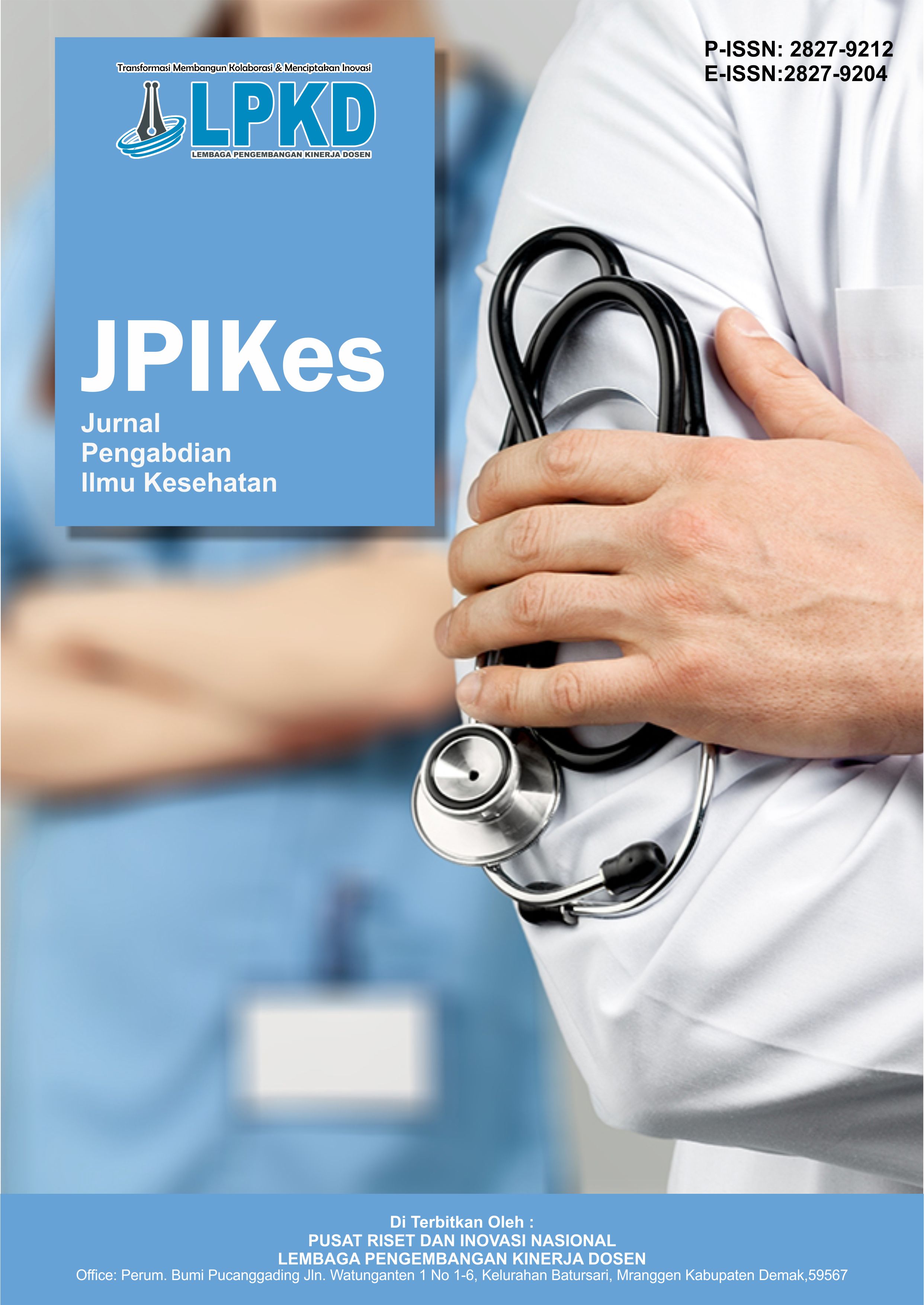Strengthening the Capacity of Healthcare Providers through the Introduction of Hematological Indices as Sepsis Markers
DOI:
https://doi.org/10.55606/jpikes.v5i3.5914Keywords:
Mean Platelet Volume (MPV), Neutrophil-Lymphocyte Count Ratio, Platelet indices, Procalcitonin, Sepsis.Abstract
Sepsis is the most common cause of increased mortality and morbidity. Culture is a gold standard, but it is time-consuming and has a low positive rate. Currently, procalcitonin is a reliable biomarker for diagnosing and predicting sepsis, but the cost is high, and it is not always available in every laboratory facility. Objective: To examine neutrophil-lymphocyte count ratio(NLCR), platelet distribution width(PDW), and Mean Platelet Volume(MPV), which can be used as markers of sepsis compared with Procalcitonin(PCT). Method: This was a cross-sectional study of 40 adult patients who entered the Emergency Department. The study took place from May 2017 to June 2017. All patients had blood samples taken on the first day of treatment. Blood culture is used as the gold standard. PCT, NLRC, PDW, and MPV values were compared between patients with positive and negative blood cultures. Results: of 40 adult patients, 25 had positive blood culture, and 15 had negative results. The performance of PCT, NLRC, PDW, and MPV was significantly higher in patients with positive blood culture compared with the negative consequence AUC=0.915/0.768/0.756/0.733, P=<0.001/0.005/0.012/0.007,respectively).NLCR was found to have a better diagnostic efficiency for predicting sepsis, with greater sensitivity and accuracy than platelet indices. Spearman correlation test showed a significant correlation between NLCR and PCT levels in sepsis patients (rs=0.504; P=0.001). The combination of NLCR, PDW, and MPV demonstrated a good diagnostic performance (sensitivity 76%, specificity 66,7%), similar to procalcitonin (sensitivity 88%, specificity 66,7%). Conclusion: The increase of NLCR has an opportunity to be an indirect marker of increased PCT levels. Combining these three parameters could be a marker to distinguish sepsis from non-sepsis.
Downloads
References
Cho, S. Y., et al. (2013). Mean platelet volume in patients with increased procalcitonin level. Platelets, 24(3), 246–247. https://doi.org/10.3109/09537104.2012.685119
Guclu, E., Durmaz, Y., & Karabay, O. (2013). Effect of severe sepsis on platelet count and its indices. African Health Sciences, 13(2), 333–338. https://doi.org/10.4314/ahs.v13i2.19
Hiew, T. M., Tan, A. M., & Cheng, H. K. (1992). Clinical features and haematological indices of bacterial infections in young infants. Singapore Medical Journal, 33(2), 125–130.
Hoeboer, S. H., van der Geest, P. J., et al. (2015). The diagnostic accuracy of procalcitonin for bacteraemia: A systematic review and meta-analysis. Clinical Microbiology and Infection, 21(5), 474–481. https://doi.org/10.1016/j.cmi.2014.12.026
Kim, C. H., Kim, S. J., et al. (2015). An increase in mean platelet volume from baseline is associated with mortality in patients with severe sepsis or septic shock. PLoS ONE, 10(3), e0119437. https://doi.org/10.1371/journal.pone.0119437
Liu, Y., Hou, J. H., Li, Q., Chen, K., Wang, S. N., & Wang, J. M. (2016). Diagnostic value of neutrophil-lymphocyte ratio in sepsis: A meta-analysis. American Journal of Emergency Medicine, 34(3), 547–553. https://doi.org/10.1016/j.ajem.2015.12.055
Nugroho, A., & Nawawi, A. M. (2013). Hubungan antara rasio neutrofil-limfosit dan skor sequential organ failure assessment pada pasien yang dirawat di ruang intensive care unit. Jurnal Anestesi Perioperatif, 1(3), 189–196. https://doi.org/10.15851/jap.v1n3.198
Nurdani, A. (n.d.). Korelasi rasio neutrofil-limfosit dengan kadar prokalsitonin pada pasien sepsis: Penelitian analitik observasional cross sectional di Instalasi Rawat Inap Medik RSUD Dr. Soetomo Surabaya [Doctoral dissertation, Universitas Airlangga].
Pierrakos, C., & Vincent, J. L. (2010). Sepsis biomarkers: A review. Critical Care, 14(1), R15. https://doi.org/10.1186/cc8872
Sanci, V., & Padmore, R. (2013). Mean platelet volume and immature granulocyte count in ICU sepsis patients and disposition at 30 days. Age, 64(15.5), 63–70.
Vincent, J. L., & Opal, S. M. (2010). Clinical trials for sepsis: Past failures, future hopes. Infection, 38(5), 341–352. https://doi.org/10.1007/s15010-010-0040-7
Wile, M. J., Homer, L. D., Gaehler, S., Phillips, S., & Millan, J. (2001). Manual differential cell help predict bacterial infection: A multivariate analysis. American Journal of Clinical Pathology, 115(5), 644–649. https://doi.org/10.1309/J905-CKYW-4G7P-KUK8
Yanti, H. E., Soedewo, F. H., & Wardhani, P. (2017). Correlation of neutrophils/lymphocytes ratio and C-reactive protein in sepsis patients. Indonesian Journal of Clinical Pathology and Medical Laboratory, 23(2), 178–183. https://doi.org/10.24293/ijcpml.v23i2.1143
Yefta, E. K., Yuniati, T., & Rahayuningsih, S. E. (2009). Validitas eosinopenia sebagai penanda diagnosis pada sepsis neonatal bakterialis. Abstrak.
Zhang, H. B., et al. (2016). Diagnostic values of red cell distribution width, platelet distribution width, and neutrophil lymphocyte count ratio for sepsis. Experimental and Therapeutic Medicine, 12(4), 2215–2219. https://doi.org/10.3892/etm.2016.3583.
Downloads
Published
How to Cite
Issue
Section
License
Copyright (c) 2025 Jurnal Pengabdian Ilmu Kesehatan

This work is licensed under a Creative Commons Attribution-ShareAlike 4.0 International License.









